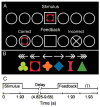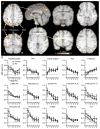On a basal ganglia role in learning and rehearsing visual-motor associations
- PMID: 19341805
- PMCID: PMC3065103
- DOI: 10.1016/j.neuroimage.2009.03.050
On a basal ganglia role in learning and rehearsing visual-motor associations
Abstract
Fronto-striatal circuitry interacts with the midbrain dopaminergic system to mediate the learning of stimulus-response associations, and these associations often guide everyday actions, but the precise role of these circuits in forming and consolidating rules remains uncertain. A means to examine basal ganglia circuit contributions to associative motor learning is to examine these process in a lesion model system, such as Parkinson's disease (PD), a basal ganglia disorder characterized by the loss of dopamine neurons. We used functional magnetic resonance imaging (MRI) to compare brain activation of PD patients with a group of healthy aged-match participants during a visual-motor associative learning task that entailed discovering and learning arbitrary associations between a set of six visual stimuli and corresponding spatial locations by moving a joystick-controlled cursor. We tested the hypothesis that PD would recruit more areas than age-matched controls during learning and also show increased activation in commonly activated regions, probably in the parietal and premotor cortices, and the cerebellum, perhaps as compensatory mechanisms for their disrupted fronto-striatal networks. PD had no effect in acquiring the associative relationships and learning-related activation in several key frontal cortical and subcortical structures. However, we found that PD modified activation in other areas, including those in the cerebellum and frontal, and parietal cortex, particularly during initial learning. These results may suggest that the basal ganglia circuits become active more so during the initial formation of rule-based behavior.
Figures






Similar articles
-
Experience-dependent activation patterns in human brain during visual-motor associative learning.J Neurosci. 2003 Nov 19;23(33):10540-7. doi: 10.1523/JNEUROSCI.23-33-10540.2003. J Neurosci. 2003. PMID: 14627638 Free PMC article.
-
The differential role of premotor frontal cortex and basal ganglia in motor sequence learning: evidence from focal basal ganglia lesions.Learn Mem. 2002 Nov-Dec;9(6):376-86. doi: 10.1101/lm.48402. Learn Mem. 2002. PMID: 12464697 Free PMC article.
-
A role of the basal ganglia and midbrain nuclei for initiation of motor sequences.Neuroimage. 2008 Feb 1;39(3):1356-69. doi: 10.1016/j.neuroimage.2007.09.069. Epub 2007 Oct 16. Neuroimage. 2008. PMID: 18024158
-
Functional anatomy of thalamus and basal ganglia.Childs Nerv Syst. 2002 Aug;18(8):386-404. doi: 10.1007/s00381-002-0604-1. Epub 2002 Jul 26. Childs Nerv Syst. 2002. PMID: 12192499 Review.
-
Differential roles of the frontal cortex, basal ganglia, and cerebellum in visuomotor sequence learning.Neurobiol Learn Mem. 1998 Jul-Sep;70(1-2):137-49. doi: 10.1006/nlme.1998.3844. Neurobiol Learn Mem. 1998. PMID: 9753593 Review. No abstract available.
Cited by
-
Cerebellar Contribution to Motor and Non-motor Functions in Parkinson's Disease: A Meta-Analysis of fMRI Findings.Front Neurol. 2020 Feb 27;11:127. doi: 10.3389/fneur.2020.00127. eCollection 2020. Front Neurol. 2020. PMID: 32174883 Free PMC article.
-
Basal ganglia-dependent processes in recalling learned visual-motor adaptations.Exp Brain Res. 2011 Mar;209(3):385-93. doi: 10.1007/s00221-011-2561-y. Epub 2011 Feb 11. Exp Brain Res. 2011. PMID: 21311878
-
Changes in brain activation patterns according to cross-training effect in serial reaction time task: An functional MRI study.Neural Regen Res. 2013 Mar 5;8(7):639-46. doi: 10.3969/j.issn.1673-5374.2013.07.008. Neural Regen Res. 2013. PMID: 25206709 Free PMC article.
-
Selective role for striatal and prefrontal regions in processing first trial feedback during single-trial associative learning.Brain Res. 2012 Jun 6;1458:56-66. doi: 10.1016/j.brainres.2012.04.010. Epub 2012 Apr 17. Brain Res. 2012. PMID: 22560503 Free PMC article. Clinical Trial.
-
Cerebellar functional abnormalities in early stage drug-naïve and medicated Parkinson's disease.J Neurol. 2019 Jul;266(7):1578-1587. doi: 10.1007/s00415-019-09294-0. Epub 2019 Mar 28. J Neurol. 2019. PMID: 30923933
References
-
- Alexander GE, DeLong MR, Strick PL. Parallel organization of functionally segregated circuits linking basal ganglia and cortex. Annu Rev Neurosci. 1986;9:357–381. - PubMed
-
- Berardelli A, Rothwell JC, Thompson PD, Hallett M. Pathophysiology of bradykinesia in Parkinson’s disease. Brain. 2001;124:2131–2146. - PubMed
-
- Bezard E, Gross CE, Brotchie JM. Presymptomatic compensation in Parkinson’s disease is not dopamine-mediated. Trends Neurosci. 2003;26:215–221. - PubMed
-
- Botvinick MM, Cohen JD, Carter CS. Conflict monitoring and anterior cingulate cortex: an update. Trends Cogn Sci. 2004;8:539–546. - PubMed
Publication types
MeSH terms
Grants and funding
LinkOut - more resources
Full Text Sources
Medical

